Feeling
thoroughly shaken up from the arduous journey, it was a relief to finally
arrive in He Kai. Little black haired pigs roamed freely amongst 3-5m tall tea
trees, with thick, robust trunks that rose a meter out of the ground before
branching out into a leafy spray. Compared to the over picked, pruned &
wispy trees we had seen in Yiwu, it appeared as if we had arrived in gu shu
wonderland. Despite being at 1,400-1,600m elevation, He Kai is still considered semi-tropical and has thousands of old tea trees ranging from 100 - 800 years old.
Unfortunately,
the local Lahu tribes people only pick the tea, most of the maocha production is done at several “chu zhi suo” (初制所 maocha processing workshops) operated by Hani minority and Han Chinese traders. These workshops buy fresh leaves from the farmers at less than RMB 30/kg, and process them into maocha, selling them onto puer buyers like
myself for RMB 150-300/kg (remember it takes 4kg of fresh leaves &
labour to make 1kg of maocha).
According to Rishi (who neglected to credit The Leaf), Fair Trade programs have funded road hardening, toilets & temples, but the key to improving people’s lives here is surely to train them to process & market maocha themselves so they can capture a bigger share of their tea’s true market value.
According to Rishi (who neglected to credit The Leaf), Fair Trade programs have funded road hardening, toilets & temples, but the key to improving people’s lives here is surely to train them to process & market maocha themselves so they can capture a bigger share of their tea’s true market value.
As we
arrived a local Lahu man was trying to offload a bag of leaves he had picked.
He seemed dazed as if he’d been smoking opium, his clothes were
tattered & dusty, but he wore an incongruously flashy red hiphop cap,
raked to one side. The “chu zhi suo” manager turned him away because he had
picked too many old leaves, and the leaves had been in the bag too long, and
withered too much. The man barely put up a fight, and just shuffled off into
the distance with his unwanted leaves.
Maocha was
spread out to dry on a bamboo platform by the side of the road, but the constant
passing of motorcycles & pickups kicked up a lot of sandy dust that no
doubt ends up in the tea. Sure enough when we entered the “chu zhi suo” to
sample the maocha, we found it lackluster, with low contrast in the leaves, and
very weak fragrance. When thrown into the air, clouds of fine dust flew from
the tea. It was simply too unappealing to buy, even at the cheap price of RMB
150 / kg.
Hidden
amongst the trees, we came across a more professional chu zhi suo owned by
“Zhen Wei Hao” (臻味号). Several tea tourists had pitched
their tents on the verandah and were picking & processing their own maocha.
A steady stream of tea pickers turned up to sell their freshly picked leaves.
These were laid out to wither on 3 long tables with a ventilation fan installed
underneath. They weren’t firing any tea when we visited, but outside on large
bamboo mats, maocha processed the day before, was soaking up the sun, away from
the dust of the road.
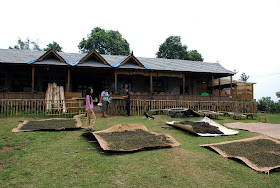 |
| Zhen Wei Hao's maocha processing facility in HeKai |
 |
| He Kai's ancient tea trees actually form a canopy |
The
surrounding tea garden was astounding, the ancient trees in He Kai stand tall
& proud, forming a dense canopy of leaves. Their sturdy
branches support orchids, lichen & other epiphytes. They are excellent
examples of healthy, organic, gu shu tea trees.
With the little black pigs going about their business underfoot, He Kai’s ancient tea garden is a most charming & photogenic place.
 |
| Epiphytic orchids & bromeliads |
| Branches dripping with mosses & lichens |
 |
| This tree named 西保四号 is older than 600 years. |
With the little black pigs going about their business underfoot, He Kai’s ancient tea garden is a most charming & photogenic place.
On the downside,
we saw many farmers using motorcycles on the walking tracks up through the
trees, leaving deep ruts that are causing erosion. In some parts the path has
deepened into a one foot deep crevasse.
And for
some reason, the maocha did not impress. We drank several batches at Zhen Wei
Hao’s facility but still were not inspired to buy. The tea lacked fragrance, or
depth of body to speak of. Perhaps it was because it had rained recently, and
there was too much water content in the leaves. I wanted so much to like the
tea, because the trees were amazing and the price was good, but we left empty
handed.
It was time
to move on. Newly bulldozed roads laced into the distance, but people here are still accustomed to walking kilometers to get
anywhere. Strung out along the road were colorful Lahu kids with
dyed hair walking home from school. We passed by one village of ramshackle huts with corrugated tin roofing and a few brick outhouses. Overhead electricity cables
and a few solar water heaters were the only sign that we were in the 21st
century.
We passed
through the village of Bang Pen (帮盆 often pronounced & spelt as Ban Pen), stopping briefly to pick up some maocha samples. The Lahu villagers here seem to be doing a little better, perhaps because a lot of their tea successfully makes it way into Lao Ban Zhang cakes ;) I noticed several had built small PVC glass houses for sun drying maocha, and a large maocha processing
facility that was attracting buyers in big SUVs.
But it as
we drove closer to Lao Ban Zhang (老班章 or LBZ), the true economic impact of puer driven investment
became clear.
First we
noticed the tea shrubs by the side of the road starting to look very stressed & over picked. Many were
clinging grimly to the edge of a precipice, roots half exposed where the road had been widened.
Then the disfigured village of Lao Ban Zhang came into view, huge chunks of hillside had been carved out for
new housing & roads. One wonders how many tea trees have been lost in the process. The village is going through a construction boom, with
white cement walls & blue ceramic roofing defining the new architectural style. Many homes already
have a pickup truck and several motorcycles parked outside. The contrast between Lao Ban Zhang and Hekai could not have been more stark.
This rapid modernization is ugly but inevitable, as much as those of us living in the first world selfishly want the few remaining tribal villages to preserve their environment & traditional way of life, the modern conveniences of machinery, large concrete homes & paved roads have an irreversible appeal. It is interesting to ponder that even though Lao Ban Zhang's trees are commercially over exploited & sometimes blended, they still produce better tasting tea than He Kai's ancient trees, and therefore bring dramatic wealth & progress into the farmers lives.
Is this primarily an outcome of better maocha processing & marketing? How much genetic & environmental advantages could Lao Ban Zhang trees really have over nearby Bangpen?
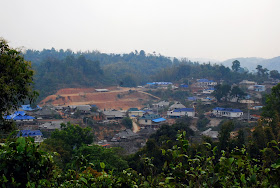 |
| New landscaping in Lao Ban Zhang |
 |
| Construction boom in Lao Ban Zhang |
Is this primarily an outcome of better maocha processing & marketing? How much genetic & environmental advantages could Lao Ban Zhang trees really have over nearby Bangpen?
To be
continued in Part 2: Lao Ban Zhang…
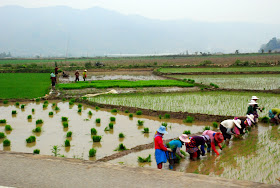
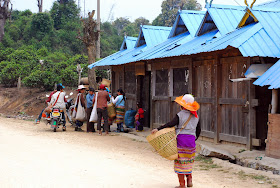






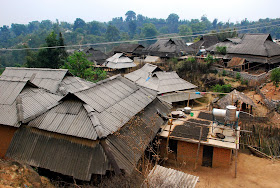
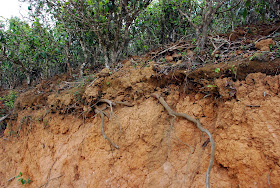
Nice post. Totally agree. Can't help but think that in different hands and with a little more care, those trees could produce incredible tea.
ReplyDelete-D{